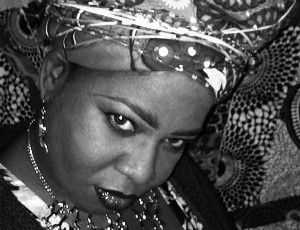She Wears Many Crowns, Dr. Yemonja Smalls' exhibit at Harold Washington Library Center, features vibrant and colorful paintings of women wearing headdresses of traditional African textiles. The artist presents The Making of a Crown: Collaborative Art Making Amongst a Tribe at 2 p.m. Saturday, June 25 at Harold Washington Library Center.
In addition to being a talented artist, Yemonja Smalls has a doctorate in clinical psychology from Louisiana State University and recently completed her master's in art therapy from the School of the Art Institute of Chicago. We sat down with Yemonja to learn more about how these two sides of her life mesh.
Q: Your background is in clinical psychology, in fact you have a Ph.D. in that field. What made you choose to go back to school to study art therapy?
A: Actually, my artist identity began her development long before I embarked upon the journey to get my doctorate. I have been “making” since I was a child. Simply this, when asked to eulogize my dear grandmother at her homegoing, I struggled with how to do it. I believe God gave me the words to say by having me describe my grandmother in terms of a painting I had done of her. I described her energy, personality and the depth of love she had for each of us in blended colors. The created image spoke volumes to my heart and to others. It was my first formal introduction to art therapy. After doing some research, it only made sense that it serves as a perfect opportunity to match-mate my passions—helping through creating.
Q: How do you think art can help people?
A: One of my favorite questions. In therapy, art can function as another mode of communication, and just like the nonverbal cues we give, the process of creating reveals much about our life challenges, unearthing hidden pains that one has no words to express, and helps to identify life goals. As an art therapist, I encourage this expression through art-making. On several occasions, collectors have said my works pointed them to thoughts of their beliefs about their own life purpose, providing encouragement through rocky experiences, and sometimes just serving as a reflection of their joys in life. Exploration through use of varied creative materials and conceptual directives lays a foundation for safe viewing and speaking of even traumatic past narratives.
Q: What country did you visit on your trip to Africa, and how did that trip influence the work you are exhibiting at the library?
A: As a result of being awarded the John W. Kurtich fellowship, I had the awesome opportunity to spend time collaborating in Tanzania with my SAIC cohort, Global Alliance and students who traveled with us from Kenya and Tanzania. It was wonderful to be immersed in the culture and to walk amongst those I can only refer to as “queens.” The colorful regalia worn by the women there seemed to suggest royalty even amongst the villagers moving along in their daily lives.
Q: In your library program, you will be bringing people together to do a collaborative art project as a "tribe." What does being in a tribe mean?
A: A tribe generally denotes a social group of distinct people, consisting of families or communities linked by economics, religious identities and common culture. I wanted to play with the idea of people of varying backgrounds, cultures, genders and affinities joining together under a common interest, making crowns together, touching another culture, and in so doing, join it, albeit temporary.
Support for Smalls' collaborative art event is provided by CPL's Women's History Month Committee. Smalls' exhibit is on display through July 15 in the Popular Library and Congress Corridor East Display Window on the ground floor of Harold Washington Library Center.


